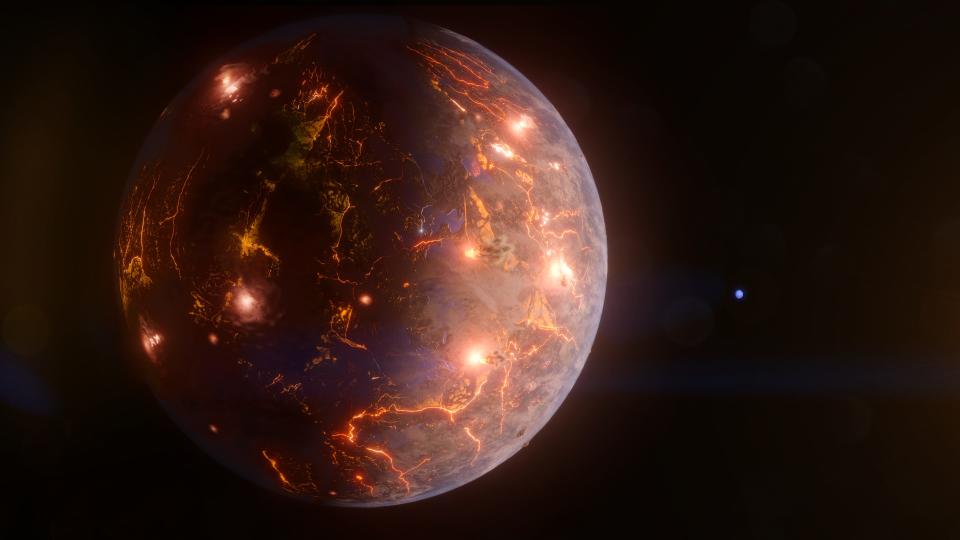Star Wars-like volcanic planet discovered orbiting red dwarf star
If you saw "Star Wars: Revenge of the Sith," it shouldn't be difficult to imagine a planet completely covered by volcanoes and flowing lava.
Astronomers using NASA space-based telescopes believe they've found such a planet orbiting a distant red dwarf star. Called LP791-18 d, astronomers suggest the planet is slightly larger and more massive than Earth.
“LP 791-18 d is tidally locked, which means the same side constantly faces its star,” said Björn Benneke, a co-author and astronomy professor at the Trottier Institute for Research on Exoplanets at the University of Montreal, who planned and supervised the study. “The day side would probably be too hot for liquid water to exist on the surface. But the amount of volcanic activity we suspect occurs all over the planet could sustain an atmosphere, which may allow water to condense on the night side.”
NASA study: Oceans likely orbiting Uranus
More science to come: NASA scientists add years to Voyager 2 power supply
Complete coverage: Look for more space industry news now
How they found it
Astronomers found and have studied "Planet D" using data from NASA’s TESS (Transiting Exoplanet Survey Satellite) and retired Spitzer Space Telescope, as well as a suite of ground-based observatories.
A paper about the planet appears in the May 17 edition of the scientific journal Nature.
In the same neighborhood

LP 791-18 d orbits a small red dwarf star about 90 light-years away in the southern constellation Crater.
Astronomers already knew about two other worlds in the system before this discovery, called LP 791-18 b and c. The inner planet b is about 20% bigger than Earth. The outer planet c is about 2.5 times Earth’s size and more than seven times its mass.
Planetary friction
During each orbit, planets c and d pass very close to each other. As they pass each other, planet c with its greater mass creates a gravitational tug on planet d - which makes d's orbit around its star somewhat elliptical. Planet d is slightly deformed with each orbit of its star and that can create enough internal friction to literally rip apart the planet's crust, spewing lava across the surface.
It's the same kind of tugging that occurs on Jupiter's moon, Io, the most volcanically active place in our solar system.
OK, so what?
OK, so you're thinking "why is this discover a big deal?"
Well, simply put, planet d sits on the inner edge of the habitable zone - that's the traditional distance from a start where scientists believe liquid water could exist on a planet's surface. A planet as geologically active as astronomers believe planet d to be, could mean it has an atmosphere and tempertures on the planet's night side might be cool enough for water to condense on the surface.
What's next?
The James Webb Space Telescope will soon be conducting observations of planet c and the science team has stated planet d would be an exceptional candidate for the telescope to observe.
“A big question in astrobiology, the field that broadly studies the origins of life on Earth and beyond, is if tectonic or volcanic activity is necessary for life,” said co-author Jessie Christiansen, a research scientist at NASA’s Exoplanet Science Institute at the California Institute of Technology. “In addition to potentially providing an atmosphere, these processes could churn up materials that would otherwise sink down and get trapped in the crust, including those we think are important for life, like carbon.”
Spitzer's late discovery
The Spitzer telescope was decommissioned in early 2020 and the observations of planet d were among the last of its mission.
“It is incredible to read about the continuation of discoveries and publications years beyond Spitzer’s end of mission,” said Joseph Hunt, Spitzer project manager at NASA’s Jet Propulsion Laboratory in Southern California. “That really shows the success of our first-class engineers and scientists. Together they built not only a spacecraft but also a data set that continues to be an asset for the astrophysics community.”
Look for all of our space related coverage at floridatoday.com/space
This article originally appeared on Florida Today: Astronomers discover exoplanet blanketed in spewing volcanoes

